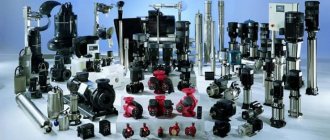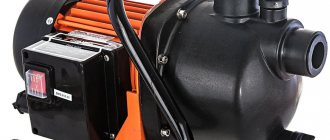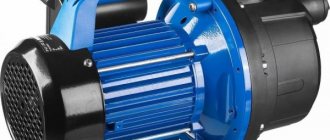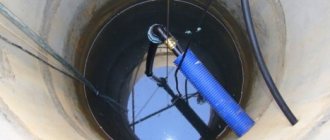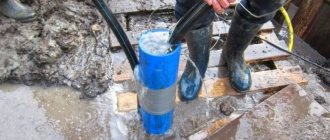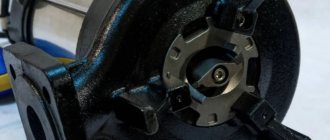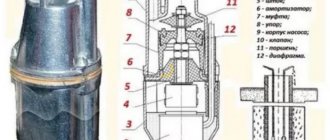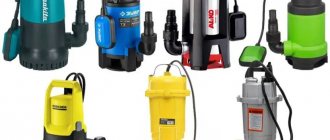Owners of personal plots and country houses quite often face a common problem - deep groundwater.
Ordinary pumping equipment located on the surface is not always capable of raising water to the surface, so it is necessary to use ejector pumping stations. These devices are much more efficient and allow you to get water from depths of no more than 50 meters, and then pump it for the needs of users. In order to find out all the technical parameters, as well as the specific nuances of the correct use of such equipment, you just need to carefully read this article, which contains answers to almost all the questions that arise when installing similar equipment.
In what cases is an ejector needed?
Before dealing with the question of what an ejector is, you should find out why a pumping station equipped with it is needed. Essentially, an ejector (or ejector pump) is a device in which the energy of motion of one medium moving at high speed is transferred to another medium. Thus, the operating principle of an ejector pumping station is based on Bernoulli’s law: if a reduced pressure of one medium is created in a narrowing section of the pipeline, this will cause suction into the formed flow of another medium and its transfer from the suction point.
Everyone knows well: the greater the depth of the source, the harder it is to raise water from it to the surface. As a rule, if the depth of the source is more than seven meters, then a conventional surface pump has difficulty performing its functions. Of course, to solve this problem, you can use a more productive submersible pump, but it is better to go the other way and purchase an ejector for a surface-type pumping station, significantly improving the characteristics of the equipment used.
External ejector prepared for immersion into the well
By using a pumping station with an ejector, the liquid pressure in the main pipeline increases, while the energy of the fast flow of the liquid medium flowing through its separate branch is used. Ejectors, as a rule, work in conjunction with jet-type pumps - water-jet, liquid-mercury, steam-mercury and steam-oil.
An ejector for a pumping station is especially relevant if it is necessary to increase the power of an already installed or planned installation of a station with a surface pump. In such cases, the ejector installation allows you to increase the depth of water intake from the reservoir to 20–40 meters.
Difference from injector
Both of these devices are jet devices, that is, for suctioning liquid and gaseous substances.
An ejector is a device in which kinetic energy is transferred from a working medium at high speed to a non-working, that is, passive, medium through their displacement.
An injector is a device in which gases and liquids are compressed.
The main difference between these devices is the method of transmitting energy to the passive medium. For example, in an injector the supply occurs due to pressure, and in an ejector the supply occurs due to the creation of a self-priming effect.
Operating principle of the ejector
The deeper the water is, the more difficult it is to bring it to the surface. In practice, if the well depth is more than seven meters, the surface pump has difficulty coping with its tasks.
Of course, for very deep wells it is more appropriate to purchase a high-performance submersible pump. But with the help of an ejector, it is possible to improve the performance of a surface pump to an acceptable level and at significantly lower cost.
The ejector is a small but very effective device. This unit has a relatively simple design; you can even make it yourself from scrap materials. The operating principle is based on giving the water flow additional acceleration, which will increase the amount of water coming from the source per unit of time.
This solution is especially convenient for those who are going to install or have already installed a pumping station with a surface pump. The ejector will allow you to increase the depth of water intake to 20-40 meters.
It should also be noted that the purchase of more powerful pumping equipment will lead to a noticeable increase in energy consumption. In this sense, the ejector will bring noticeable benefits.
The ejector for a surface pump consists of the following elements:
- suction chamber;
- mixing unit;
- diffuser;
- narrowed nozzle.
The operation of the device is based on Bernoulli's principle. It states that if the speed of a flow increases, an area of low pressure is created around it. In this way, a rarefaction effect is achieved. Water enters through a nozzle, the diameter of which is smaller than the size of the rest of the structure.
This diagram allows you to get an idea of the design and operating principle of an ejector for a pumping station. The accelerated reverse flow creates an area of low pressure and transfers kinetic energy to the main flow of water
A slight narrowing gives the water flow a noticeable acceleration. Water enters the mixer chamber, creating an area of reduced pressure inside it. Under the influence of this process, a stream of water under higher pressure enters the mixer through the suction chamber.
Water enters the ejector not from the well, but from the pump. Those. The ejector must be installed in such a way that part of the water raised by the pump returns to the ejector through the nozzle. The kinetic energy of this accelerated flow will be constantly transferred to the mass of water that is absorbed from the source.
To create an area of rarefied pressure inside the ejector, use a special fitting, the diameter of which is smaller than the parameters of the suction pipe
This will ensure constant acceleration of the flow. Pumping equipment will require less energy to transport water to the surface. As a result, its efficiency will increase, as will the depth from which water can be drawn.
Part of the water extracted in this way is again sent through the recirculation pipe to the ejector, and the rest enters the water supply system of the house. The presence of an ejector has another “plus”. It sucks up water on its own, which additionally protects the pump from running idle, i.e. from the “dry running” situation, which is dangerous for all surface pumps.
The diagram shows the structure of the external ejector: 1- tee; 2 - fitting; 3 — adapter for water pipe; 4, 5, 6 - corners
To regulate the operation of the ejector, use a regular tap. It is installed on a recirculation pipe, through which water from the pump is directed to the ejector nozzle. Using a tap, the amount of water entering the ejector can be reduced or increased, thereby reducing or increasing the rate of return flow.
Advantages, principle of operation and installation details
A surface pump with an external ejector has the following advantages:
- work with great depths up to 50 meters;
- small dimensions and weight of the station;
- convenience of supplying water to the object;
- ability to work in extreme conditions – at temperatures from -20 to + 130 degrees.
Design and principle of operation of the internal ejector
Of course, not every steam ejector pump can boast all of the above advantages. So, some models can work in severe frost conditions, others cannot.
How does the device work?
The steam ejector pump has a fairly simple principle of operation - a small amount of water, which is located in a special tank of the device, is used to assist in drawing in liquid. The operating principle is simple but very effective.
Although, such a system does not have serious performance. But so far no one has invented a new pumping system that can draw liquid from greater depths. That's why a water ejector pump is so popular today.
The ejector for the pump is always lowered to the required depth for water intake, and the pumping system is mounted on the surface for ease of use and adjustment of the water intake system.
What it is
An ejector is a fairly small but very effective device with a simple design, so some users make it themselves. This is especially effective when the farm already has a pumping station with a powerful pump of various types. With an ejector, the equipment allows you to effortlessly pump out clean water from a depth of 25 to 40 meters or more.
By using such additional equipment, each user saves money that would otherwise be spent on purchasing expensive equipment. If you do not yet have a similar station, but have just dug a well, then immediately purchase a product equipped with an ejector.
Design and types of pumps with ejectors
There are two options for including an ejector in the pump circuit:
- built-in;
- external node.
Functionally, these methods differ. The choice depends on the tasks that will be assigned to the pump. The built-in ejector is located in the pump design, so the suction of liquid and the creation of pressure occur inside the device. In this case, the pump, of course, is also immersed in the well.
On the one hand, this reduces the overall dimensions of the installation. Such a pumping station is capable of working with liquid containing sand and silt. However, the device itself is quite noisy, so it is not installed near a residential building. The maximum water intake depth of such a pump is only about 8 m.
A remote ejector involves equipment of a ground pumping station. The unit itself is placed in the pipeline at depth. A tank is placed on the surface, which facilitates the operation of the pump: it creates pressure and additional vacuum. Among the disadvantages of such a device is the need to lower the second pipe, which can be inconvenient if the well diameter is limited.
The efficiency of a pump with a remote ejector is 30-35% lower than that of a “colleague” with a built-in one. But you can get water from a depth of up to 50 m. And it works much quieter. It is even placed in houses, although not in living rooms.
Attention! The remote ejector, pump and related equipment operate effectively even at a distance of 20-40 m from the well.
Rating of the best models
Caliber SVD-770Ch+E
pros
- An excellent purchase for a summer cottage or country house
- works at 5 plus, normal cost
Minuses
- plastic thread at the connection point
From 7390 ₽
The model was developed by domestic engineers, but is produced in Chinese factories, which is why there are some shortcomings: the plastic threads on the connections will not last long - they must be changed immediately, and this is an additional expense.
Grundfos JPD 4-47 PT-V
pros
- compact size, quiet operation
- A well-known company makes high-quality equipment
Minuses
- not found
From 13234 ₽
This model is designed for private buildings to normalize the pressure inside the home water supply during frequent changes, and copes well with pumping water from deep wells.
SPERONI APM 150/25
pros
- high-quality assembly, quiet but very productive work
- pumps water from deep wells without tension
Minuses
- not found
From 20800 ₽
The model is made of high quality materials, has automatic engine protection against overloads and operation without water, and is used in domestic and industrial water supply systems.
Marina APM 200/25
pros
- low energy consumption
- body and all parts made of corrosion-resistant metal
Minuses
- not found
From 24230 ₽
The model is designed for pumping only clean water without impurities from great depths; it works perfectly with wells no more than 50 m deep.
Top Aqua AUJCB-800 ejector
pros
- compact size and light weight
- easy installation and simple use
Minuses
- not found
From 6450 ₽
The model is designed for pumping water from wells or boreholes no deeper than 20 m, only for clean liquid with an impurity content of no more than 50 g/cubic meter. m.
Types of ejector devices
According to their design and operating principle, ejector pumps can belong to one of the following categories.
Steam
With the help of such ejector devices, gaseous media are pumped out of confined spaces and a rarefied state of air is maintained. Devices operating on this principle have a wide range of applications.
Steam ejector for turbine with oil cooler
Steam jet
In such devices, the energy of a steam jet is used to suck gaseous or liquid media from a confined space. The operating principle of this type of ejector is that steam escaping from the nozzle of the installation at high speed carries with it the transported medium exiting through an annular channel located around the nozzle. Ejector pumping stations of this type are used primarily for rapid pumping of water from the premises of ships for various purposes.
Installation of water heating using a steam jet ejector
Gas
Stations with an ejector of this type, the operating principle of which is based on the fact that the compression of a gas medium, initially under low pressure, occurs due to high-pressure gases, are used in the gas industry. The described process takes place in the mixing chamber, from where the flow of the pumped medium is directed to the diffuser, where it is slowed down, and hence the pressure increases.
Air (gas) ejector for chemical, energy, gas and other industries
With remote ejector
To extract water, such pumps must be lowered deep into a well or borehole. A pump with a remote ejector has two pipes. According to one of them, liquid under a certain pressure is supplied to the ejector. This leads to the development of a kind of suction jet.
A pump with an external ejector is significantly inferior in its characteristics to models with a built-in ejector. It's all about the specifics of the design.
Installation diagram of two types of ejector pumps
Thus, a pump with a remote-type ejector will be “afraid” of contaminated water and air entering the structure. Its efficiency is noticeably lower, but the pump’s remote ejector also has its own significant advantage - it can be located inside a living room.
With built-in ejector
An internal centrifugal ejector pump lifts water using artificially created vacuum.
Due to its design features, an ejector pump is much more expensive than conventional devices of this type, as it is capable of lifting water even from great depths up to 50 meters.
High performance, however, is somewhat compensated for by the high level of noise emitted during operation of the device.
Therefore, ejector pumps are installed exclusively in basements and utility rooms of residential buildings.
A modern steam ejector vacuum electric pump is a good solution for organizing a water supply system in a large enterprise and for irrigating large areas with vegetation.
Choice: built-in or external?
Depending on the installation location, there are remote and built-in ejectors. There is no big difference in the design features of these devices, but the location of the ejector still affects in some way both the installation of the pumping station and its operation.
So, built-in ejectors are usually placed inside the pump housing or in close proximity to it. As a result, the ejector takes up minimal space and does not have to be installed separately; it is enough to carry out the usual installation of the pumping station or the pump itself.
In addition, the ejector located in the housing is reliably protected from contamination. Vacuum and reverse water intake are carried out directly in the pump housing. There is no need to install additional filters to protect the ejector from clogging with sludge particles or sand.
A remote ejector for a pumping station is more difficult to install than an internal model, but this option creates a much less noise effect
However, it should be remembered that this model demonstrates maximum efficiency at shallow depths, up to 10 meters. Pumps with a built-in ejector are designed for such relatively shallow sources; their advantage is that they provide excellent incoming water pressure.
As a result, these characteristics are sufficient to use water not only for domestic needs, but also for irrigation or other economic operations. Another problem is the increased noise level, since the vibration of the operating pump is added to the sound effect of water passing through the ejector.
If you decide to install a pump with a built-in ejector, you will have to take special care of sound insulation. It is recommended to install pumps or pumping stations with a built-in ejector outside the house, for example, in a separate building or in a well caisson.
The electric motor for a pump with an ejector must be more powerful than for a similar model without an ejector.
An external or external ejector is installed at a certain distance from the pump, and this distance can be quite significant: 20-40 meters, some experts even consider 50 meters acceptable. Thus, a remote ejector can be placed directly in a water source, for example, in a well.
The external ejector does not so much increase the pump’s performance as it is designed to increase the depth of water intake from the source, which can reach 20-45 m
Of course, the noise from the operation of an ejector installed deep underground will no longer disturb the residents of the house. However, this type of device must be connected to the system using a recirculation pipe through which the water will return to the ejector.
The greater the installation depth of the device, the longer the pipe will have to be lowered into the well or well.
It is better to provide for the presence of another pipe in the well at the design stage of the device. Connecting a remote ejector also involves installing a separate storage tank from which water will be drawn for recirculation.
Such a tank allows you to reduce the load on the surface pump, saving some energy. It is worth noting that the operating efficiency of the external ejector is somewhat lower than that of models built into the pump, however, the ability to significantly increase the intake depth makes one come to terms with this drawback.
When using an external ejector, there is no need to place the pumping station directly near the water source. It can be installed in the basement of a residential building. The distance to the source can vary within 20-40 meters; this will not affect the performance of the pumping equipment.
Details
Pumping device design
Injection pumping devices consist of two parts: a pump with an electric motor, which drives the mechanism. But the equipment has its own design features:
1.Each appliance is equipped with a non-return valve to prevent liquid from flowing back through the equipment when it is connected.
2.The device has a float device to turn off the engine when water drops in the well. It serves to protect against dry running, which could cause the pump to break.
3. The engine does not need to be lowered into the shaft; it is placed in a separate place, for example, near a well, or at a well. The end of the pump is lowered into the water, thinning the air.
4. The design consists of two discharge pipes having different sections. An injector is installed at the end of one pipe. Using injectors, you can extract liquid from deep sources.
5. to protect equipment from freezing so that it does not stop working in winter, pumps are installed in a caisson or in specially equipped pits that are insulated.
The motor requires a special installation area. When determining the area for the pump motor, it is necessary to take into account such parameters as:
1. depth of the source for pumping water.
2. distance of the well to the points of consumption.
Attention! To lift liquid from a source in a vertical position, a lot of energy is spent than in a horizontal position, so it is better to place the pump as close to the source as possible. This will use the maximum amount of pump power.
Differences between injection pumping equipment and ejector pumping equipment
To pump liquid from a well, ejector-type equipment can be used. They have their own design and operating principles. The main parts of the device include:
1.chamber into which the pumped liquid is sucked.
2.suction pipe with a narrow nozzle.
3.mixer with diffuser.
Suction devices and the motor of the ejector pump are installed both inside and outside the shaft. In the ejector type, the kinetic part of the energy of the fluid flow, which has a high speed, transfers part of the energy to the flow, which has a lower speed.
Device installation features
As already mentioned, installing an ejector built into the pump does not cause any particular problems, since the device is already located in the device body. The surface pump is simply connected to the water supply hose on one side, and also to the water supply system on the other side.
If it is used as part of a pumping station, then the pump is connected to the hydraulic accumulator through a special fitting with five outputs. In addition, the pump will need to be connected to the contacts of the pressure switch to ensure that it turns on and off automatically.
This diagram clearly shows the procedure for connecting a remote ejector to a pumping station, indicating the installation locations of all necessary components.
Before turning on the surface pump, it must be filled with water through the filling hole provided for this purpose. You cannot turn on such equipment without water, it may burn. If the pump is installed correctly, the ejector will operate without interruption.
But the installation of a remote ejector is carried out according to a more complex scheme. First, you will need to install a pipe that will ensure the return flow of water from the storage tank to the ejector. A check valve is installed on the suction section of the ejector. A mesh filter should be placed behind it to protect the device from clogging.
An adjustment valve must be installed on top of the recirculation pipe to regulate the amount of water that is directed to the ejector. This unit is not mandatory, but can significantly improve the situation with water pressure in the house.
The less water is returned to the ejector, the more of it will be left for the home's plumbing system.
The ejector is assembled before operation according to the standard scheme. A mesh filter is connected to the ejector body from below, and a Venturi tube made in the form of a plastic socket is connected to the top through the nozzle (+)
This way you can influence the water pressure in the water supply. If it is insufficient, you should slightly tighten the adjusting valve on the return line.
If the pressure is too high and creates unnecessary stress on the plumbing system, it makes sense to direct more water to the ejector in order to increase the efficiency of the pumping equipment.
Some industrial models of ejectors are already equipped with such an adjustment system. The instructions that come with the device usually describe in detail how to configure the ejector.
Water injection pump: design and application
Water injection pump
An autonomous water supply system at a dacha requires the installation of special equipment to service the well. An injection pump for water is used at a significant depth of the source.
This type of pump has a number of differences from the ejector type of device.
Area of use of the device. Injection pumping devices have special characteristics that allow them to be used to provide large volumes of water to a private home.
Manufacturing an ejector and its connection to pumping equipment
Having understood what an ejector is and having studied the principle of its operation, you will understand that you can make this simple device with your own hands. Why make an ejector with your own hands if you can purchase one without any problems? It's all about saving. Finding drawings from which you can make such a device yourself does not present any particular problems, and to make it you do not need expensive consumables and complex equipment.
How to make an ejector and connect it to the pump? For this purpose you need to prepare the following components:
- female tee;
- union;
- couplings, elbows and other fitting elements.
Components for a homemade ejector
The ejector is manufactured according to the following algorithm.
- A fitting is screwed into the lower part of the tee, and this is done so that the narrow branch pipe of the latter is inside the tee, but does not protrude from its reverse side. The distance from the end of the narrow branch pipe of the fitting to the upper end of the tee should be about two to three millimeters. If the fitting is too long, then the end of its narrow pipe is ground off; if it is short, then it is extended using a polymer tube.
- An adapter with an external thread is screwed into the upper part of the tee, which will connect to the suction line of the pump.
- A bend in the form of an angle is screwed into the lower part of the tee with the fitting already installed, which will connect to the recirculation pipe of the ejector.
- A bend in the form of an angle is also screwed into the side branch pipe of the tee, to which a pipe supplying water from the well is connected using a collet clamp.
- Homemade ejector assembly
All threaded connections made during the manufacture of a homemade ejector must be sealed, which is ensured by the use of FUM tape. On the pipe through which water will be drawn from the source, a check valve and a mesh filter should be placed, which will protect the ejector from clogging. For the pipes with which the ejector will be connected to the pump and storage tank, which ensures water recirculation in the system, you can choose products made from both metal-plastic and polyethylene. In the second option, installation does not require collet clamps, but special crimping elements.
After all the required connections are made, the homemade ejector is placed in the well, and the entire pipeline system is filled with water. Only after this can the first start-up of the pumping station be carried out.
Personal assembly of the ejector
To make a simple ejector device, you will need plumbing fittings that are always on hand or commercially available - a tee with internal threads, couplings and bends.
The main element is an unequal tee, into the lower part of which a fitting with an external thread is inserted. When installing the fitting, it is necessary to ensure that it does not reach the upper edge of the tee by 2-3 mm. To do this, if necessary, it is modified by filing or extending with a polyethylene tube. The fitting will play the role of a nozzle, so the vacuum in the tee body and the water pressure at the outlet depend on the accuracy of its installation.
A polyethylene pipe is connected to the top of the tee through an adapter to supply water to the system. On the thread of the lower part, in addition to the fitting, there is an outlet for supplying recirculated water from the pump. To draw water from a well or a well, a side pipe of a tee with a polyethylene tube connected through an outlet is used. Its diameter should be smaller than that of the main passage of the fitting.
As for the dimensions, for the manufacture of an ejector that provides water supply to a small house or cottage, it will be sufficient to use a ¾" tee with a ¾" side fitting and an internal fitting with a diameter of 12 mm.
Pipe connection procedure
To connect to adjacent elements of the system, you can use polyethylene or metal-plastic pipes. The pipe connected to the side pipe with the installed check valve and filter must be long enough to be immersed in the well; it is secured first.
A recirculation pipeline is connected to the lower end of the device with a narrowed fitting, connected to the water tank and necessary to create a return flow.
The upper part of the ejector is connected through a pipeline to the surface pump, and the assembly of the homemade ejector installation is completed.
What should you consider when connecting?
An ejector electric vacuum pump (it does not matter whether it is a pump with a remote ejector or a built-in one) must be installed in compliance with all recommendations (they are in the instructions for a specific device model).
For example, after the outlet pipe it is necessary to install a check valve. It will prevent the unit from idling. The pipe drawing in water must be located at a depth of at least 1 m. The diameter of the well, in this case, should not be less than 12 cm in diameter.
If you purchased an expensive ejector for a pump, you can also modify it - install automation. It will allow you to automate the operation of the system, and can also significantly extend the operational life of your unit.
A surface pump with an external ejector, as well as a pump with an internal ejector, are mounted using two additional manipulations:
- For recirculation, a special gasket must be mounted on the pipe. It extends from the ejector to the pressure pipeline. The pump ejector is then connected to the suction port of the equipment.
- The water filter pipe, as well as the return valve, must be mounted in the same way to the suction pipe of the ejector.
Connecting the ejector pump
If necessary, the above-described recirculation system is additionally equipped with a tincture tap. It is necessary if the water in the well is at a level significantly higher than the level for which the equipment is designed.
The water pressure on the ejector can be adjusted by increasing the pressure in the water supply system. There are even devices that have “fine” details for tuning this parameter. Usually this detail is described in detail in the documentation for the unit.
Initial launch and further operation
It is recommended to perform the initial start-up of the pumping station according to the following scheme:
- Pour water into the pump through the special hole.
- Turn off the tap through which water flows from the pumping station to the water supply system.
- Turn on the pump for about 10-20 seconds and turn it off immediately.
- Open the tap and bleed some of the air from the system.
- Repeat the cycle of short-term pump on/off in combination with bleeding air until the pipes are filled with water.
- Turn on the pump again.
- Wait until the accumulator is filled and the pump automatically turns off.
- Open any water tap.
- Wait until the water flows out of the accumulator and the pump turns on automatically.
If water does not flow when starting up a system with an ejector, it is possible that air is somehow leaking into the pipes, or the initial filling with water was not performed correctly. It makes sense to check the presence and condition of the check valve. If it is not there, the water will simply pour into the well, and the pipes will remain empty.
These points should also be taken into account when using a pumping station with an ejector, which is started after long-term storage. It is best to check the check valve, the integrity of the pipes and the tightness of the connections immediately.
The lower pipe of the ejector, through which water is drawn, should be protected from contamination using a coarse strainer (+)
If everything is in order, but water does not flow, you need to check the voltage supplied to the pumping station. If it is too low, the pump simply cannot operate at full capacity. You should establish a normal power supply to the equipment, and the problem will disappear.
If an ejector is needed to improve the water pressure in the system, and not to increase the depth of water intake, you can use the homemade ejector model described above.
But it does not need to be immersed in water; it can be placed in a convenient place near the surface pump. In this case, the ejector will work approximately the same as the built-in industrial production model.
Using a homemade external option
A built-in ejector is usually purchased at the same time as a pump, but the external model is often made by hand.
It will be useful to consider the creation process and the procedure for connecting such a device. In order to make an ejector, you will need such parts as a tee with internal threaded connections, fittings, fittings, bends, couplings, etc.
Sources
- https://met-all.org/nasosy/ezhektor-chto-eto-takoe-printsip-raboty-ustrojstvo-ezhektornyj-nasos.html
- https://sovet-ingenera.com/vodosnab/nasosy/ezhektor-dlya-nasosnoj-stancii.html
- https://nasosovnet.ru/centr/ezhektornyj-nasos.html
- https://sandizain.ru/na-dache/nasosy/nasos-bytovoj-s-vstroennym-i-vynosnym-ezhektorom.html
- https://VodaSovet.ru/nasos/ezhektor-dlya-nasosnoj-stantsii

